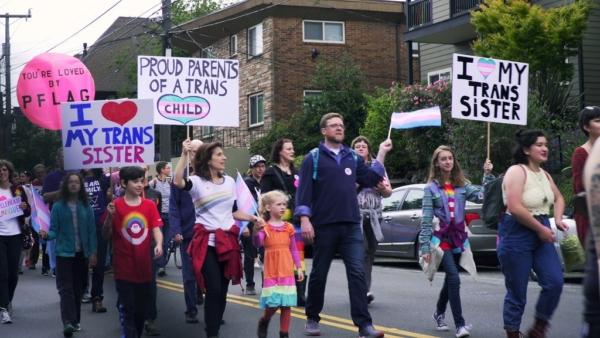This documentary follows the fight in Washington State over a law that would have forced transgender people to use restrooms in compliance with the gender on their birth certificates. While the film covers this specific bathroom bill, it also serves as a top-rate introduction into what transgenderism actually is, made by two cisgender parents as they learn how to raise their transgender child.
Filmmaker Vlada Knowlton takes a memoirist approach in the first few minutes to explain how she got involved in this fight. Her daughter Annabelle, who was born as a male, expressed to her parents at a very young age that she was not supposed to be a boy. Vlada and her husband, Chadd (also a filmmaker), educated themselves and got involved with local parents of trans children to find support in making the best life for their child. Meanwhile, several discriminatory “bathroom bills” were being proposed in the state legislature. This was in the beginning of 2016, the year that the Human Rights Campaign would call the most dangerous year for transgender Americans, when all over the country anti-trans policies were being adopted by local governments.
Knowlton takes us to hearings, town halls, and even a press event held by the innocent-sounding “Just Want Privacy Campaign.” The film presents both sides and their main arguments, and then brings on an expert, equipped with statistical data to point out that the anti-trans arguments are founded on nothing but conjecture and misunderstanding, namely the erroneous correlation between gender and sexuality. Meaning, these are two very different things.
The current transgender rights movement is often compared to the civil rights movement of the 1950s and ’60s, and certainly this film treads down that well-worn and completely equivalent path. However, an argument I had not heard before was comparing the trans movement to the Americans with Disabilities Act of 1990. This film effectively walks beginners through what transgender really is, and once you divorce it from its mistaken correlation with sexuality, it rings clear that being born of the wrong gender really is a disability. That is just one of many examples when The Most Dangerous Year presents the counterargument and reveals how this movement is really about human rights.
The DIY spirit of the film lends to its message that those who want to fight for civil rights have to take it upon themselves to get organized. The sheer fact that Washington State had six of these bills proposed in just one year speaks loudly to the unrelenting nature of the anti-trans movement. This film would do wonders when shown in classrooms and at screenings for the misinformed public.

















Leave A Comment